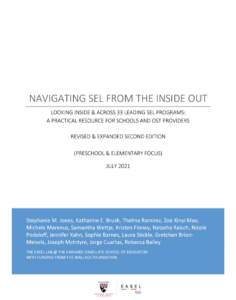Navigating SEL From the Inside Out
Stephanie M. Jones, Katharine E. Brush, Thelma Ramirez, Zoe Xinyi Mao, Michele Marenus, Samantha Wettje, Kristen Finney, Natasha Raisch, Nicole Podoloff, Jennifer Kahn, Sophie Barnes, Laura Stickle, Gretchen BrionMeisels, Joseph McIntyre, Jorge Cuartas, Rebecca Bailey; EASEL Lab at Harvard GSE, Wallace Foundation
As SEL initiatives become more widespread, educators and other child and youth service providers are seeking to identify SEL programs that (1) meet their specific goals or needs; (2) fulfill certain requirements; (3) align with existing school-, district-, and state-wide regulations and initiatives; and (4) can be adapted and implemented with success in their unique settings. While this document is not necessarily exhaustive of all SEL programs, the EASEL Lab team hopes it will be a useful resource to inform these efforts.
This report consists of the following:
- Background Information on SEL, including a framework to help stakeholders consider the broader context and developmental issues that should be part of any SEL-building effort.
- Recommendations for Adapting SEL for Out-of-School Time (OST) Settings, including common challenges and practical steps for selecting and aligning SEL and OST efforts.
- Recommendations for Achieving Equitable SEL, including common barriers and best practices for ensuring SEL is relevant, affirming, and effective for students of all backgrounds, cultures, and identities, and that it pushes against rather than perpetuates systems of oppression and harm.
- Recommendations for a Trauma-Sensitive Approach to SEL, including a set of principles, practices, and recommendations for ensuring SEL programming is trauma-informed.
- Summary Tables for Looking Across Programs that illustrate which programs have the greatest or least emphasis on specific skills/skill areas, instructional strategies, and program components.
- Individual Profiles for 33 SEL Programs, which describe each program in more detail; compare its skill focus, instructional methods, and program component offerings to those of other programs; and highlight any unique features that emerged from our analyses of each program’s curriculum and/or activities.
- “How to Use the Navigating SEL Guide” Supplement, which include processes and worksheets to help stakeholders use the information in this guide and the accompanying program profiles to select an SEL program that best meets the needs of their students and setting, and to ultimately make informed decisions about SEL programming.
